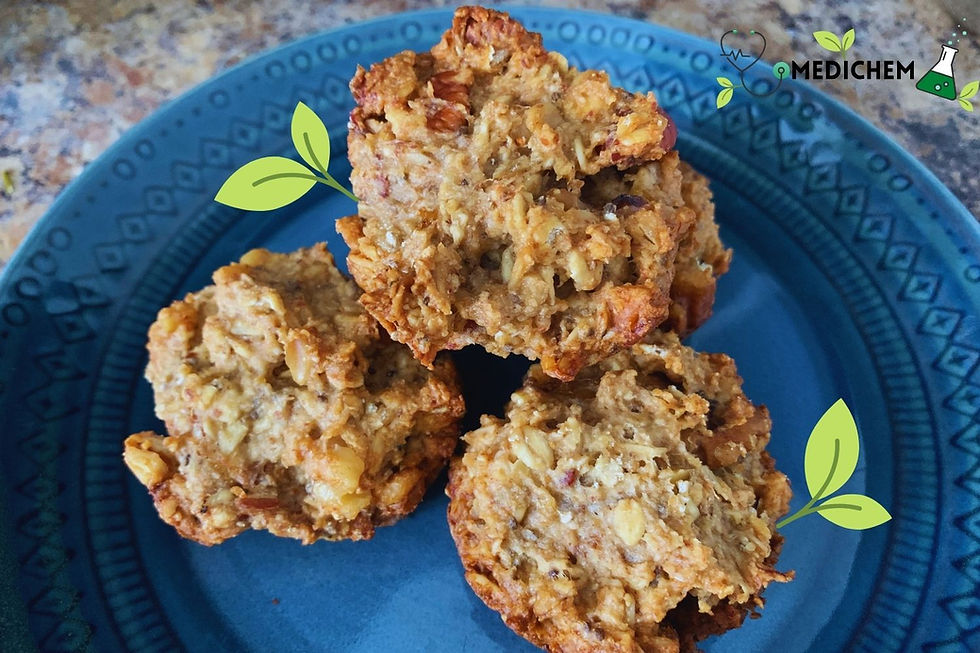Fiber Deficiency: The Powerful Nutrient Missing From Most Plates
- Dr. Chelsea Anorma

- May 22
- 4 min read
Updated: Jun 12
Did you know that in America, 95% of adults and kids aren’t consuming enough of one essential nutrient? This is a nutrient associated with better heart health, improved digestion, and lower risks of obesity, diabetes, and cancer—and yet only about 5 out of every 100 people eat enough!
That nutrient is the humble fiber. In the ongoing tug-of-war between fat and carbs, and with the popularity of high-protein everything, fiber has been largely neglected. But getting enough fiber might be the single most powerful change you could make to your diet right now.
What Is Fiber, Really? (And Why We Don’t Digest It)
Fiber is actually a class of carbohydrates. There are many types of fiber molecules, usually made up of long chains of single carbohydrate units, such as glucose or fructose.
What makes fiber different from other carbs—like sugar and starch—is that it can’t be broken down for energy by the body. That means it doesn’t add calories to your diet or cause your blood glucose to spike.

Fibers are also generally divided into two classes: soluble fiber, which absorbs water, and insoluble fiber, which does not.
How Fiber Benefits Your Body
Fiber’s unique chemical structure explains why it brings so many health benefits.
Most famously, it supports regular digestion. Insoluble fiber keeps things moving through your digestive system, while soluble fiber attracts water and forms a gel-like substance that smooths the process.
But fiber's benefits go far beyond the bathroom:
Steadier energy and less hunger: Because fiber doesn’t break down into glucose, it avoids blood sugar and insulin spikes and slows the absorption of other nutrients. This helps your body maintain energy and register fullness. (Fun fact: it activates some of the same pathways as weight loss drugs like Ozempic!)
Lower diabetes risk: Eating more than 25 grams of fiber per day is linked to a lower risk of developing type 2 diabetes.
Heart health: Fiber helps remove cholesterol from the small intestine before it’s reabsorbed, which may reduce the risk of cardiovascular disease.
Cancer prevention: Consuming over 28.5 grams of fiber daily is associated with lower risks of certain cancers, including colon and breast cancer.
Gut microbiome support: Fiber feeds the beneficial bacteria in your gut, helping them thrive. A diverse and well-fed microbiome is linked to everything from improved immune function to better mental health.
Why Most People Don’t Get Enough Fiber
Despite all these benefits, many people still fall short. Why?
A major reason is our modern food environment. Ultra-processed foods dominate grocery store shelves and restaurant menus. These foods are designed to be hyper-palatable and convenient, but often have their natural fiber stripped out—leaving behind calories without the nutritional benefits.
There are also common misconceptions:
Many assume a “whole grain” label means high fiber—but that’s not always true. Always check the nutrition facts and look for dietary fiber.
Some believe fiber only comes from bland cereals or supplements like Metamucil. Not so!
Making Fiber Delicious: Real-World Recipes
The best way to get fiber? Real, whole plant foods. Fruits, vegetables, beans, nuts, seeds, and whole grains all contain fiber. A varied diet with generous servings of these foods can help you hit your fiber goals.
Here’s an example: Black Bean and Hummus Stuffed Sweet Potato

This recipe is satisfying, flavorful, and contains fiber from multiple ingredients—so you get a mix of benefits without needing a huge portion of any one food. With sweet-savory balance and just five ingredients, it comes together in under 30 minutes.
Fiber Content (approximate):
Sweet potato (1/2 large): 2g
Black beans (1/2 cup): 7g
Hummus (1 Tbsp): 1g
Total: ~10g of fiber in one delicious plate!
Quick Recipe Preview (Makes 2 Servings):
Ingredients:
1 large sweet potato (steamed)
1 cup black beans
2 Tbsp hummus
2 Tbsp water (to thin the hummus)
Chopped green onion
Quick Prep: Steam the sweet potato until fork-tender, then slice it in half. Warm the black beans and season as desired. Thin the hummus with water to make it drizzle-friendly. Assemble each portion with half the sweet potato, ½ cup beans, 1 Tbsp thinned hummus, and a sprinkle of green onion.
Leftovers keep well in the fridge and can be easily reheated for a fiber-rich meal tomorrow!
👉 Get the full step-by-step recipe here — email subscribers get access to full nutrition facts, serving scale-up options, and other exclusive recipes.
How to Start Eating More Fiber (Without Overhauling Your Life)
Ready to start adding more fiber to your day? Good news: you don’t need to overhaul everything at once.
In fact, it’s best to start slow—especially if your current fiber intake is low. This gives your digestive system and gut microbiome time to adjust.
Try starting with just one high-fiber meal per day (like the stuffed sweet potato!). From there, gradually work toward the recommended 25–40 grams of fiber per day.
Want support on your fiber journey?
Book a discovery call for a personalized, doable approach to meeting your fiber needs.
Getting more fiber isn’t a miracle cure—but it’s one of the simplest, most effective ways to improve your health, energy, and digestion starting today.

Dr. Chelsea Anorma, PhD, NASM-CNC, is a Certified Nutrition Coach and Chemical Biology PhD helping overwhelmed women regain energy and confidence through sustainable, science-backed wellness coaching.



Comments